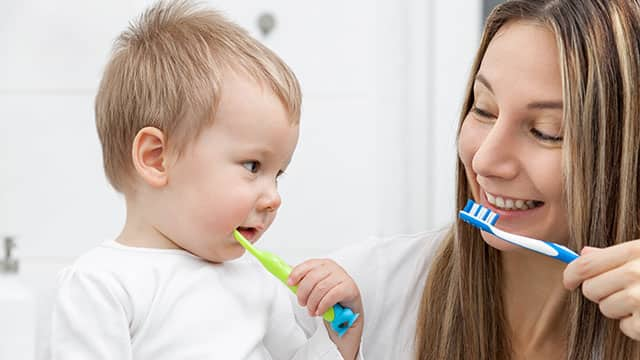These are typical concerns for parents. But with a bit of preparation, you'll be confident and ready for the arrival of your baby's primary teeth! Let's specifically go over how to prepare for the eruption of their back teeth, also known as molars.
By the time your child's molars begin to erupt, you've become adept at addressing their teething pain. Molars coming in might feel like a more significant hurdle in your child's oral development. But while molars are larger than the rest of their teeth and cover a larger surface area, there isn't a significant difference in their eruption process.
When to Expect Molars
A baby's first molars will usually make an appearance between 13 and 19 months. However, every child is different, so don't worry too much if your child's first molars show up a bit early or late. Late tooth eruption can run in families, so if your teeth didn't come in on schedule, expect a delay in your child's teeth too. If you're worried that your baby's molars aren't erupting on time, visit their pediatric dentist, who can investigate any potential issues.
What Primary Molars Do
Did you know that primary molars are usually the last teeth to erupt and the last to fall out? Your child's primary teeth, also known as baby or milk teeth, are not permanent. But they're still critical for the healthy development of their precious smile.
Your child will have eight primary molars (two on either side of their mouth, on both their top and bottom jaw). These teeth make way for their permanent set (known as first, second, and third molars), totaling twelve permanent molars (three on either side of their mouth on the top and bottom jaw). Note that the third molars (famously known as wisdom teeth) might be removed before their eruption.
Permanent first molars have a unique job. While their primary molars were most likely the last of that set to come in, their permanent molars are the first to come in. Known as the "6-year molars," because they can begin to erupt at age six, they serve as the first "placeholders" in your child's mouth. These first permanent teeth set the stage for the shape of your kid's lower jaw as it supports the placement for the rest of their teeth.
Pain During Their Eruption
When your baby first starts to teethe, the surrounding area can become red and swollen. You've probably experienced this if your baby already has some teeth. The first front tooth is often the most sensitive, but molars coming in can also be painful for your child.
Unlike an incisor, which can cut the gum more efficiently, a molar's larger and duller surface area makes the process more uncomfortable for some children. Pain tolerance is different for every child, but the soreness in this area of the gumline can make eating particularly difficult.
As the molars pass through the gums, your baby may become very cranky, even if they're usually easygoing. Some common symptoms are trouble sleeping through the night and a refusal to eat. We know that this can be very stressful for both you and your baby, but hang time! Remember that this phase of growth isn't for long!
Diet Change for New Molars
Changing your child's diet can help treat their pain and discomfort. If your child eats solid foods, switching to frozen or cold food or from solid foods to liquids, can help lessen or numb their pain. A good rule is to ultimately look for foods that can counter the pressure of the tooth erupting. Examples include a chilled carrot, which can be a good antidote for baby molar eruption pain, or placing chilled, solid food in a mesh feeder that are easy to gnaw on.
Ice water is also an excellent way to relieve the sensation. If your baby will accept it, fill their bottle with cool or icy water to help numb the area. This might be too intense for some kids, but others will welcome it once they feel its desensitizing effects.
Oral Care for Molar Eruption
It's exciting to think that with the eruption of their child's molars, they'll have a complete set of 20 primary teeth! And with these new back teeth comes even greater importance of getting oral care right. Molars may have a larger surface area, but they're harder to reach when cleaning. You may already know this from your own experience of attempting to reach far back into your mouth to floss every day! Because of their hard-to-reach location, there's an opportunity for plaque to build up and develop early cavities (caries).
As these molars appear, you should already be well into your child's oral care routine. But if you're concerned you haven't perfected it, now is a valuable time to assess where you should be in your child's regimen. The American Academy of Pediatric Dentistry recommends the following oral care timeline:
- Schedule a dental visit by the first tooth's eruption or the first birthday, and schedule a checkup every six months.
- Use toothpaste as soon as their first tooth erupts.
- Brush your child's teeth twice daily as soon as their first tooth erupts.
- Brush your child's teeth with a small, soft-bristled brush tailored for children.
Is It the Same with Permanent Molars?
Of course, an older child who's already getting their permanent teeth may experience some familiar soreness. Luckily, ibuprofen, soft foods, and cool ice water can help with the discomfort at this stage as well. Just remind your children to properly floss their molars and use a tool like a small dental mirror to locate any areas where food gets stuck. It's also essential to schedule your child's six-month dental checkups to ensure that permanent molars are erupting correctly.
We know that you care about your child's milestones. From their height and weight to their first steps, it's all so special! And dental milestones are just as important. As your child's primary molars come in, you're in the home stretch to help them through the discomforts of tooth eruption. Remember that besides addressing short-term pain relief and changing their diet, focusing on big-picture oral care will help your child develop healthy molars and habits well into adulthood!
Oral Care Center articles are reviewed by an oral health medical professional. This information is for educational purposes only. This content is not intended to be a substitute for professional medical advice, diagnosis or treatment. Always seek the advice of your dentist, physician or other qualified healthcare provider.
ORAL HEALTH QUIZ
What's behind your smile?
Take our Oral Health assessment to get the most from your oral care routine
ORAL HEALTH QUIZ
What's behind your smile?
Take our Oral Health assessment to get the most from your oral care routine















